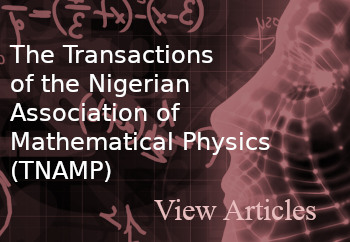SURFACE ENERGY CALCULATION FOR RHODIUM (RH) TREATED AS FCC METAL WITH BOTH POSITIVE AND NEGATIVE CAUCHY’S DISCREPANCY BY USING THE GEAM
DOI:
https://doi.org/10.60787/jnamp-v67i1-347Keywords:
Geam, Embedding Fuction, Inter-AtomicAbstract
The fcc metal Rhodium is treated as having both positive and negative Cauchy’s discrepancy and the three low-index surfaces of the metal calculated using the generalized embedded-atom method (GEAM), a model developed by [1]. The low-index surface energies investigated are {, and }. The predicted values are in good agreement with the experimental values. The result shows having the lowest and having the highest energy value.
Downloads
References
Oni-Ojo A. A., Idiodi J. O. A. and Aiyohuyin E. O. Embedded atom method for materials with a negative Cauchy discrepancy, J. Nig. Math. Phys. Vol. 11, 509-514. (2007).
Daw M. S., Baskes M. I. Semi-empirical, quantum mechanical calculation of hydrogen embrittlement in metals, Phys. Rev. Lett. 50, 1285-1287. (1983).
Daw M. S., Baskes M. I. Embedded-atom method: Derivation and application to impurities, surfaces, and other defects in metals, Phys. Rev. B 29, 6443-6453. (1984).
Adams J.B. and Foiles S.M., Development of an embedded-atom potential for a bcc metal: Vanadium, Phys. Rev. B 41, 3316-3328. (1990).
Baskes M. I. Modified embedded-atom potentials for cubic materials and impurities, Phys. Rev. B 46, 2727-2742. (1992)
Baskes M. I., Nelson J.S., and Wright A. F. Semi-empirical modified embedded atom potentials for Silicon and Germanium, Phys. Rev. B 40, 6085-6094. (1989).
Smith J. R. and Banerjea A., New Approach to Calculation of Total Energies of Solids with Defects: Surface-Energy Anisotropies Phys. Rev. Letters 59, 2451-2454, (1987).
Foiles S. M., Baskes M. I. and Daw M. S. Embedded-atom-method functions for the fcc metals Cu, Ag, Au, Ni, Pd, Pt, and their alloys, Phys. Rev. B 33, 7983-7991, (1986).
Johnson R. A. Analytic nearest-neighbour model for fcc metals, Phys. Rev. B 37, 3924-3931. (1988).
Baskes M. I, Application of the Embedded-Atom Method to Covalent Materials: A Semiempirical Potential for Silicon. Phys. Rev. Lett. 59, 2666-2669. (1987).
Johnson R. A and Oh D. J., Analytical Embedded Atom Method model for bcc metals. J. Mater. Res. 4, 1195-1201, (1989).
Oh D. J, Johnson R. A., Simple embedded atom method for fcc and hcp metals, J. Mater. Res. 3, 471-478, (1988).
Yan-Wi Wen, Jian-Min Zhang, Surface energy calculation of the fcc metals by using the MAEAM, Computational material science, 144, 163-167. (2007).
Yan-Wi Wen, Jian-Min Zhang, Surface energy calculation of the bcc metals by using the MAEAM, Computational material science, 42, 281-285. (2008).
Simons G. and Wang H, Single Crystal Elastic Constants and Calculated Aggregate Properties (MIT Press Cambridge, MA, 1977)
Yuan X., Takahashi K., Ouyang Y. and Onzawa T, Development of a modified embedded atom method for bcc transition metals: Lithium, Modelling Simul. Mater. Sci. Eng. Vol. 11, 447-456. (2003)
Idiodi J. O. A. and Aghemenloh E. On the problem of low surface energies within the embedded atom method, J. Nig. Math. Phys. Vol. 2, 285-296. (1998).
Idiodi J. O. A. and Aghemenloh E. Implementation of Equivalent Crystal theory within a generalized embedded-atom method, J. Nig. Math. Phys. Vol. 3, 167-178. (1999).
Oni-Ojo A. A, (2011), Surface energies of fcc metals within the embedded atom methods, M.Phil. Thesis, University of Benin, Edo state, Nigeria.
Aghemenloh E. and Idiodi J.O.A., Equivalent-crystal theory of fcc metal surfaces, J. Nig. Math. Phys., Vol. 2. 271-284. (1998)
Downloads
Published
Issue
Section
License
Copyright (c) 2024 The Journals of the Nigerian Association of Mathematical Physics

This work is licensed under a Creative Commons Attribution-NonCommercial-ShareAlike 4.0 International License.




